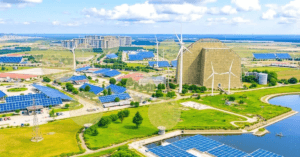Global Energy Demand Soars by 2.2% in 2024: Surging Growth, Renewable Energy, and New Trends
Global energy demand increased by 2.2% in 2024, driven primarily by a surge in electricity consumption. Emerging economies accounted for most of this growth, while advanced economies saw a return to energy demand growth after years of decline. The power sector led the charge, with global electricity use rising by 4.3%, fueled by record temperatures, greater industrial demand, and the growth of electric vehicles and data centers. Renewable energy and nuclear power played a major role, meeting 80% of the increased electricity demand.
Natural gas demand also rose, while oil consumption grew slowly, partly due to the rise of electric vehicles. Coal demand was up by 1%, primarily due to extreme heat in China and India. Despite the rise in energy use, clean energy technologies helped limit CO2 emissions, with a 0.8% increase in global emissions. Advanced economies saw a drop in emissions, while the majority of emissions growth came from emerging markets.

Global Energy Demand Soars by 2.2% in 2024: Surging Growth, Renewable Energy, and New Trends
In 2024, the world experienced a major spike in energy demand, largely driven by soaring electricity use across the globe. Reports from the International Energy Agency (IEA) reveal that energy consumption grew by 2.2%, significantly higher than the 1.3% average annual growth seen over the previous decade. While developing economies were responsible for over 80% of this increase, developed countries also contributed, marking their first notable rise in energy use in years, with a nearly 1% uptick.
The electricity sector played a central role in this growth. Global power consumption surged by 4.3%, almost double the average rate of the past ten years. This jump was fueled by record-breaking heatwaves, which spiked demand for air conditioning, alongside rising industrial activity, the spread of electric vehicles (EVs), and the energy needs of data centers and artificial intelligence (AI) technologies.
Renewables and Nuclear Lead the Charge
Most of the new electricity demand was met by clean energy sources. Renewable energy installations hit an unprecedented 700 gigawatts (GW) in capacity, while nuclear power saw its fifth-largest expansion in three decades. Together, renewables and nuclear accounted for 80% of the growth in global electricity production, representing 40% of total power generation—the highest share ever recorded. Natural gas also gained traction, particularly in power plants, as countries sought flexible energy sources.
Fossil Fuels: Mixed Trends
Among fossil fuels, natural gas demand rose the fastest at 2.7%, while oil consumption grew modestly at 0.8%. Notably, oil’s share of global energy use dropped below 30% for the first time, partly due to EVs. Sales of electric cars skyrocketed by over 25%, reducing oil reliance in transportation. Coal use, however, inched up by 1%, driven by extreme heat in China and India that intensified cooling demands.
Emissions Growth Slows Despite Energy Surge
Despite higher energy consumption, CO2 emissions increased by just 0.8% to 37.8 billion tonnes. Clean energy technologies like solar, wind, nuclear, EVs, and heat pumps played a critical role in curbing emissions, preventing an estimated 2.6 billion tonnes of CO2 annually. This progress highlights a growing disconnect between economic growth and emissions.
Developed nations reduced their emissions by 1.1% in 2024, continuing a 50-year decline even as their economies expanded. In contrast, emerging economies—particularly outside China—drove most emissions growth. Alarmingly, per-person emissions in these regions now exceed those in wealthier countries.
Key Takeaways from the IEA Report
The IEA underscores several pivotal trends:
- Oil Demand Plateaus: EVs and efficiency measures are slowing oil’s growth.
- Electricity Dominates: Power systems are becoming the backbone of global energy use.
- Clean Energy Acceleration: Renewables and nuclear are reshaping how we produce electricity.
- Emissions Decoupling: Economic growth no longer hinges on fossil fuel reliance.
In summary, 2024 marked a turning point where clean energy not only met rising demand but also redefined the relationship between energy use and environmental impact. While challenges remain, the shift toward low-carbon technologies offers a roadmap for sustainable growth in the decades ahead.
You must be logged in to post a comment.